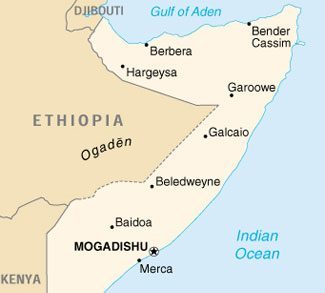The Westgate shopping mall attack brought into lurid and tragic detail what African security experts have known all along: Al-Shabab is still a serious security threat to Horn of Africa countries and beyond.
As the Geopoliticalmonitor reported in the past, al-Shabab is an Islamic fundamentalist group that was originally born out of the Islamic Courts Union (ICU) – a more moderate Islamist group that took over most of Somalia in 2006, including the capital city of Mogadishu. An Islamist organization controlling such a geopolitically crucial territory did not sit well with US authorities at the time however, so Ethiopia was encouraged to launch a joint invasion with the Transitional Federal Government (TFG) and drive the ICU out of Somalia’s key cities. Various US government figures have subsequently denied involvement in this Ethiopian invasion, but leaked diplomatic cables seem to suggest otherwise.
The fall of the ICU served to radicalize the Islamist movement in Somalia, and thus al-Shabab, or “the youth,” was born.
Though the TFG re-established itself in parts of Mogadishu thanks to Ethiopian forces, al-Shabab slowly expanded its territorial hold across large swathes of southern Somalia in the absence of any strong central government. However, the situation on the ground began to alter dramatically after February 2012, when the UN Security Council voted to expand the formerly Mogadishu-bound African Union Mission in Somalia (AMISOM) by 5,000 troops and amend its mandate to include coordinated operations with Somali security forces to “reduce the threat posed by al-Shabab… and establish conditions for effective government country-wide.” AMISOM and Somali forces launched a series of operations throughout the country, dislodging al-Shabab from territory that it had in some cases held on to for years.
The AMISOM-led campaign shifted al-Shabab’s operational focus from consolidating a territorial base in Somalia to a guerilla strategy aimed at punishing the African countries contributing troops to AMISOM. This logic underpins the recent attack on the Westgate mall in Kenya, a country that contributes 5,500 troops to the AMISOM mission. Al-Shabab has also launched attacks on foreign targets before 2012, such as the 2010 World Cup bombings in Uganda that killed 74 people.
Gauging the potential threat of al-Shabab is difficult due to the group’s fractured patchwork of tribal, ethnic, ideological, and strategic motivations and the district lack of a rigidly defined chain of command, which is even more pronounced following the group’s military defeats in Somalia. These interests can be roughly divided into three clusters. First, there are those with ideological goals, manifesting in a desire to spread al-Shabab’s rigid interpretation of Sharia law. This bloc seeks to expand al-Shabab’s territorial base in Somalia, interests that align closely with the second, more nationalistic group that seeks to drive the AMISOM foreigners out of their country. Finally, there are the more outward-looking jihadists that want to make good on the group’s 2012 declaration of alignment with al Qaeda and launch high-profile terrorist attacks against Western interests within Somalia and beyond.
There are several reasons to believe that the third, more jihadist-oriented cluster of interests is in ascent. For one, Ahmed Abdi Godane, the group’s current leader, is known to eschew the nationalism card and support a strategy of global jihad. Though there have been a few leadership clashes in the past year, some of them violent, the Westgate mall attack will help to solidify Godane’s position, as well as his strategic priorities. Funding may also be another important consideration. When al-Shabab lost most of its territorial foothold in Somalia, it lost the port city of Kismayo, where the charcoal trade had hitherto provided the group with an important source of revenue to the tune of between $35 and $50 million a year. The Westgate mall attack will help al-Shabab make up this revenue by giving it prominent placing among the list of international jihadist groups, allowing the group to pull in more funding from conventional sources in Saudi Arabia, Yemen, Syria, Iran, Qatar, and Eritrea.
The list of potential targets in an al-Shabab jihadist push is long. There are the AMISOM countries of Kenya, Uganda, Burundi, and Djibouti, two of which have already experienced al-Shabab attacks. There is also the question of al-Shabab operations in the strategically crucial Gulf of Aden and southern Yemen. Ahmed Godane has also frequently voiced a desire to stage an attack within the United States.
A future attack is highly likely, though not necessarily one that is planned and executed by al-Shabab in its current form. The international response after the Westgate attack, whether in the form of coordinated operations by French, British, and US Special Forces or added money and troops for the AMISOM mission, will inevitably disrupt the capacity of al-Shabab to organize attacks. Yet conversely, the al-Shabab “brand” will be in ascendance due to such a high-profile success in Nairobi, drawing in new recruits and causing other Islamist groups to rally under its flag. This was apparently one of the original goals of the Westgate attack, evident in the way that al-Shabab live-tweeted the bloody progression of its assault.
The end result will be an enlarged al-Shabab, though one with a looser and more decentralized organizational structure, much like how “al Qaeda” has become more a global branding than a coherent organization in the post-9/11 era. This development does not bode well for long-term stability in the Horn of Africa, because a far-reaching al-Shabab jihadist brand is far more destructive than an al-Shabab focused on retaking Mogadishu.




